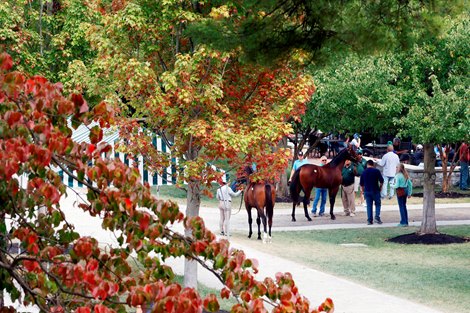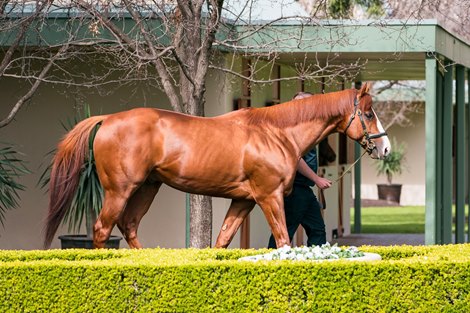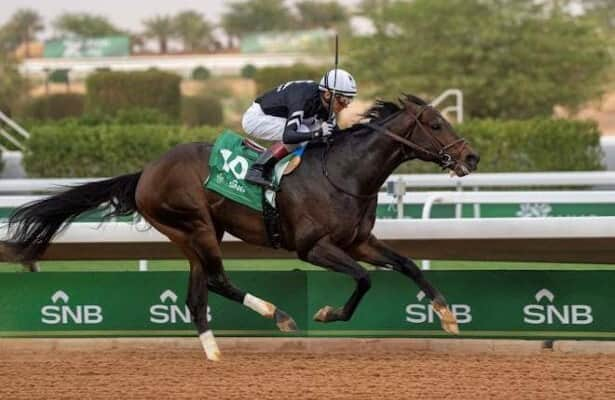Racing Post’s Martin Stevens chats to Keeneland’s Ed Prosser following the release of the Keeneland September Yearling Sale catalog.
Ed Prosser is a real hero of mine. For decades he toiled away in bloodstock journalism, traveling up and down the country diligently filing reports on sales both blockbuster and bread-and-butter. Then, around 12 years ago, he was snapped up to succeed Tim Preston as European representative of the storied Kentucky auction house Keeneland.
I can only dream of leaving behind the sometimes monotonous business of writing up pedigrees by being headhunted for such a prestigious ambassadorial role in the breeding industry. Mind you, knowing my luck, I’d be made the face of speculums instead.
Seeing as I’m stuck where I am for now I recently asked Ed, the beau ideal of poacher turned gamekeeper, whether my hunch that there would be renewed enthusiasm among European buyers for shopping in Kentucky this year, on the back of Justify ‘s rise to become a highly in-demand sire on both sides of the Atlantic, was indeed correct.
The usual suspects from Europe were active at the exclusive Fasig-Tipton’s The Saratoga Sale Aug. 5-6, but are others booking in for the more equal-opportunities Keeneland September Yearling Sale, which begins its 12-session run Sept. 9?
“People have been noticing what’s been happening on the track and there’s definitely one or two people who haven’t been before who are interested in coming, and quite a few who have been in the past but not for a good few years, and are also hopefully going to be in attendance again,” said Ed.
“On top of that, all of the regulars seem to be keen to come as usual. I’d say there hasn’t been the same sense of buzz among Europeans since the final crop of Scat Daddy yearlings went through the ring. That drew a great crowd of people.”
U.S. Stallions winning overseas
Scat Daddy’s son Justify, a $500,000 2016 Keeneland September Yearling Sale graduate himself and the source of six group/grade 1 winners including Ballydoyle superstars City of Troy and Opera Singer in his first two crops, is the most obvious but by no means the only driver of increased demand.
City of Troy wins the Derby at Epsom Racecourse
“I think people in Europe who want to win the best races have realized that they might perhaps be reducing their chances of doing that by not at least looking at U.S. sales,” added Ed. “There’s only a small number of American-bred horses running over here at the moment, but they’re consistently punching above their weight.
“Look at last season, for example. Buyers are famously focused on trying to find Royal Ascot 2-year-old winners. Well, two of the four 2-year-old group races were won by horses bought at sales in America: the Norfolk Stakes by Valiant Force and the Queen Mary Stakes by Crimson Advocate. If you didn’t go to America, you completely passed up the chance of buying them.
“Then of course, last year’s champion 2-year-olds City of Troy and Opera Singer were bred from Justify in America, even if they weren’t sold.
“It wasn’t just 2-year-olds, either. King of Steel, who was bought at Keeneland (in 2021) by Amo Racing, was arguably unlucky not to win the Derby but finished a very good second, and ended up rated the top 3-year-old in Britain.”
City of Troy went one better than King of Steel in the Epsom classic this year, and the fine adverts for United States-breds have continued to come this season.
“The 2-year-olds have been on another good run,” said Ed. “Shareholder won the Norfolk Stakes at Royal Ascot, Black Forza won the Richmond Stakes at Glorious Goodwood, and Ruling Court is favorite for the Two Thousand Guineas and Derby after winning so well on debut. They were all resold at the breeze-ups in Europe, but they were also available to buy as yearlings in America last year for quite a lot less.
“John Magnier was interviewed by Nick Luck after City of Troy won the Eclipse and he made the point that people will be very broadminded at the 2-year-old sales in Europe, buying horses by a good mixture of stallions, but somehow they think they can’t go and look at the same sires’ yearlings in America.

Opera Singer (far left) wins the Nassau Stakes at Goodwood
“It’s true; you sometimes hear people say there isn’t a wide enough range of U.S. sires who’d work in Europe. But results have shown that different sires will work if an effort is made to try them out. Those recent U.S.-bred 2-year-old group winners are by a variety of sires and not the first ones that people in Europe would think of. Crimson Advocate is by Nyquist, for example, while Valiant Force is by Malibu Moon, Shareholder is by Not This TIme, and Black Forza is by Complexity.
“A horse like Shareholder, who was bred by Geoffrey Von Honste (Skyfall Thoroughbreds) out of an Invincible Spirit mare, is an example of how mixing American and European pedigrees can work well, bringing fresh blood to both sides.”
He continued: “John Magnier’s thoughts have tended to be worth listening to over the years, and it’s notable that Ballydoyle have 2-year-olds this season by the likes of Gun Runner, Into Mischief, Medaglia d’Oro, and Tiz the Law, as well as American Pharoah and Justify who you’d expect. They’ve made the effort to bring progeny of those stallions over to Europe to prove that American bloodlines work everywhere.”
Justify has 59 lots in the recently published Keeneland September Yearling Sale catalog, many of whom have attractive pedigrees, as they should seeing as they are by a Triple Crown hero and were conceived at a fee of $100,000.
Nevertheless, Ed made the good point that there might be more value in the draft than expected.
“Justify needs no introduction as one of the world’s elite sires,” he said. “If you don’t at least go and look at his stock in Kentucky you’re probably missing out on the chance of getting a horse able to compete with his runners in future.
“There’s a great selection at Keeneland. They’re from his fourth crop, meaning they’re not all out of elite mares, and so some will be buyable. I think there’s a real opportunity with him this year.”
Other American Stallions
Naturally, this year’s Keeneland September catalog also features large numbers of lots by other mainstays of the North American sire ranks: 75 by Constitution , 74 by Into Mischief , 63 by Uncle Mo , 59 by Curlin , 54 by Quality Road , 40 by Tapit , and so on.
However, not all have traditionally found themselves in the crosshairs of European buyers, who expect to see proof of a U.S. sire’s efficacy on turf before getting stuck in.
“The division between sires who are perceived to work on turf and those who don’t can be a little frustrating,” said Ed. “Every stallion of note in Europe at the moment goes back to horses who were bred or bought in America in that golden era of transatlantic trade in the 1970s and ’80s.
“It created the most powerful bloodlines in Europe now, but it’s been cyclical over the years, and perhaps now the time has come to bring in more American blood. There are some very good stallions over there, it’s not quite right to think otherwise. They’ve been flying the flag pretty well on the international scene.
“You find it often takes just one good horse to click in Europe and then people will go over and buy more by the sire. But that creates a bit of a chicken and egg situation: if yearlings by a certain sire are never being exported to Europe, then that sire is never going to be showcased effectively.
“More often than not it’s the breeze-up buyers who move the market by bringing a good one by a ‘different’ sire back here. That encourages more people to go over and buy them the next year. We might see that again with Not This Time, a sire who is already popular in America but was less well known over here until Shareholder.”
Besides Justify and other big hitters, as well as those who have come up trumps for breeze-up vendors and their clientele in recent seasons, are there any more slightly under-the-radar sires Ed would pinpoint in the catalog?
“I honestly wouldn’t rule out any, there’s a great variety who would work,” he replied. “It’s worth remembering that more of the cream of the foal crop comes up for sale in America than in Europe, where racing is dominated by the big owner/breeders. You do have more of a chance to get hold of one of those iconic horses.
“I think five of the last six (American) Horses of the Year were bought at auction, not necessarily all at Keeneland: the likes of Flightline, Justify, Authentic, and Knicks Go. Also American Pharoah a little before that. On the other hand, I think the last Two Thousand Guineas winner to go through a (yearling) sale was Kameko, who just happened to be sold at Keeneland.
“But I suppose if I were pushed I would say don’t forget those old favorites who have always done buyers at home and away good turns, like Hard Spun and Speightstown, while Oscar Performance is a younger horse who is flying in America.
“Caravaggio is a very interesting one this year too. This is his final North American crop before he transferred to Japan, and there should be great interest in him after getting the likes of Porta Fortuna and Whitebeam. Maljoom looked right back to his best at Goodwood recently too. There are 35 lots by him in the sale.”
European activity in Kentucky this year might not resemble the raids on the Blue Grass made by the Coolmore partners and the Maktoum family in the 1980s, described so evocatively by Patrick Robinson in his book Horsetrader, but it should still be strong.
Perhaps the primary reason transatlantic trade in bloodlines fell into abeyance in the last few years was because the biggest buyers achieved their ends: Northern Dancer and Mr. Prospector revived stale European pedigrees and, as Ed pointed out, our dominant sires like Galileo, Dubawi , and Dark Angel all trace back to them.

The sales grounds at Keeneland
Medication Concerns Lessening
Truth be told, the process of invigorating bloodlines with outside influences should be a constant one, but it became less so out of European complacency, and also because for some time America didn’t have its house in order with medication issues, making the value of its form and therefore also its pedigrees look dubious.
Keeneland, however, has been at the forefront of the U.S. getting its act together on that score.
“We have very rigorous testing that’s available to buyers if they want peace of mind,” says Ed. “There are at least four postsale tests that can be done. Our sales testing is at least on a par with everywhere else in the world. Besides that, pretty much everyone in America puts vet reports in the repository for every horse being sold, which doesn’t necessarily happen elsewhere.
“Keeneland has also been one of the bodies very heavily involved in the creation and continued promotion of (the Horseracing Integrity and Safety Authority) to make sure there is uniform medication testing in racing throughout the country, which I think is starting to be seen to have made an impact.”
Anyone inspired to buy at Keeneland this year (no tire-kickers, I tried already) need only get in touch with Ed, who can help with arrangements and explain how everything works at the sale if you haven’t been before. You can find him this weekend at the Curragh, as Keeneland is sponsoring the Phoenix Stakes (G1) for the 15th year in a row.














